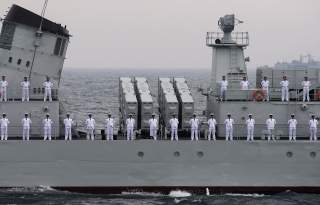The U.S. Navy Now Has a New Way to Track Chinese or North Korean Warships
Some very big and advanced UAVs.
The Navy is sending a new high-tech sea drone engineered to detect enemy ships and other targets at sea to the Pacific within a year or so, service officials said.
"Triton is tracking with its baseline configuration which will be used for an initial operational employment in spring 2018," Capt. Dan Mackin, Triton Program Manager, Persistent Maritime Unmanned Aircraft Systems, told Scout Warrior in a statement.
The Navy and Northrop Grumman have been developing the Triton autonomous drone, called the MQ-4C; Northrop and the service have recently been updating software and sensors on the new maritime drone.
The Triton has been receiving a "3.1 software" integration as part of a technical plan for the aircraft to be operational by 2018.
Recommended: The Real Reason China Has Built a Massive Military
The sensor package being designed for the aircraft includes what the Navy calls a multi-function array sensor, or MFAS.
The Triton's electronics include an electro-optical/infrared sensor, a 360-degree active electronically scanned array radar and inverse synthetic aperture radar (ISAR), among other things, Navy developers have said. The sensors create a common operational maritime picture including images, data and full-motion video. An electronic support measure is also able to detect maritime signals.
Recommended: North Korea has Thousands of Tons of Chemical Weapons
Synthetic Aperture Radar, or SAR, sends an electromagnetic signal forward and then analyzes the return signal to paint a picture or "rendering" of the terrain below. SAR is primarily used for land missions, whereas ISAR is especially engineered to zero in on targets in a maritime environment.
Recommended: Why the Korean War May Have Never Really Ended
Designed to function as a maritime version of the Air Force's Global Hawk surveillance plane, the Triton is designed for high-altitude, long-dwell ISR missions - the kind of technology suited for the geographically dispersed Pacific theater. The Air Force already has RQ-4 Global Hawks stationed at Andersen Air Force Base in Guam.
The Triton is built with a thicker, more stiffened wing compared to the Global Hawk to enable the aircraft to rapidly change altitude in adverse or icy weather conditions, he added.
The Navy also separately tested the Triton's software and sensor systems by flying them in a surrogate Gulfstream 2 airplane.
The Triton is designed to bring endurance, altitude, range and persistent stare ability over a wide, expansive area; it can stay on missions for over 24 hours at altitudes greater than 50,000 feet, Navy developers explained.
The Triton can cover broad areas out on the ocean in a single mission. The idea is to provide ship commanders with an ability to detect and see targets, threats and items of interest in real time from great distances using the sensors, cameras and data-links of the Triton system.
The Triton is an autonomous air vehicle able to chart a course without needing to be remotely piloted. Computer algorithms and on-board systems enable the aircraft to account for wind, temperature and altitude conditions.
The Navy has also announced that next generation aircraft avoidance systems are being installed on the Triton.
Last year, Northrop Grumman received a $9.6 contract to install the Automatic Response Module of the Airborne Collision Avoidance System X into the MQ-4C Triton’s avionics system.
The company will test and support the software and ensure the proper functioning of the unmanned aircraft.
The Airborne Collision Avoidance System X charts flight patterns that permit closer navigation to other aircraft while maintaining safety protocols.
Equipped with signals intelligence, C4ISR, and maritime strike capabilities, the Triton represents the Navy’s future in unmanned aircraft technology. It will also complement the P-8 Poseidon. Together, the two aircraft replace the aging P-3C Orion.
Specs include a full day’s worth of flight, an altitude limit over 10 miles, and an operational range of 8,200 nautical miles. The Navy’s program of record states that the service will field 68 aircraft.
First Triton Squadron Stationed in Guam
In addition to being stationed in Guam, Tritons will also be based in the eastern and western U.S., a location in the Middle East and in Sicily, Italy, Navy leaders said.
The Triton UAS is an intelligence, surveillance, reconnaissance drone with specially configured maritime sensors and radar systems. The 45 foot-long, 32,000-pound aircraft has a wingspan of 131 feet.

